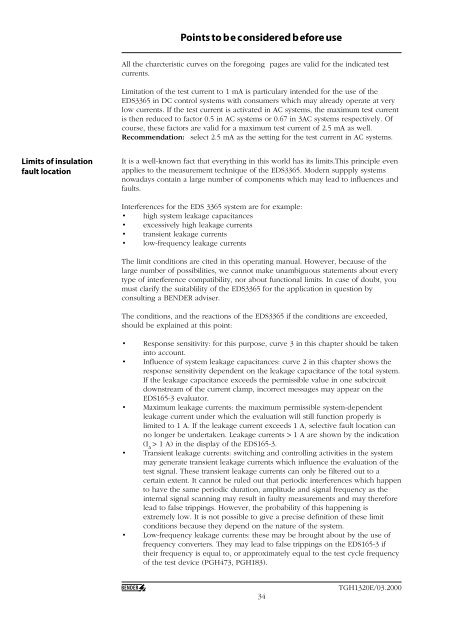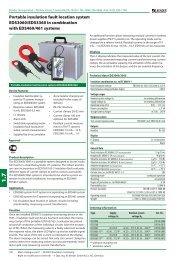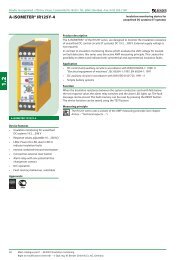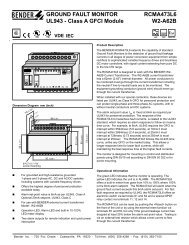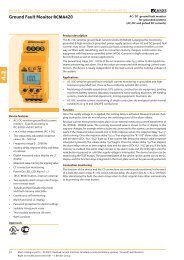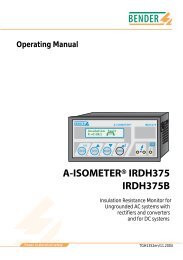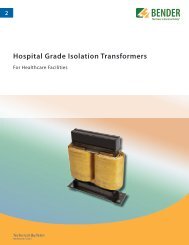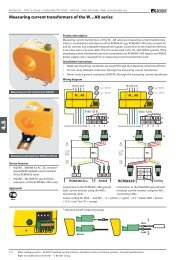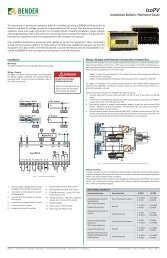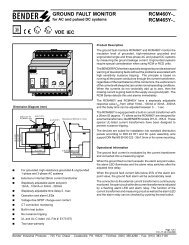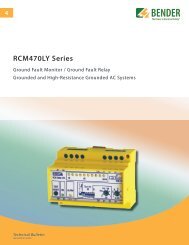EDS3365 Manual in PDF format - Bender
EDS3365 Manual in PDF format - Bender
EDS3365 Manual in PDF format - Bender
- No tags were found...
Create successful ePaper yourself
Turn your PDF publications into a flip-book with our unique Google optimized e-Paper software.
Po<strong>in</strong>ts to be considered before useAll the charcteristic curves on the forego<strong>in</strong>g pages are valid for the <strong>in</strong>dicated testcurrents.Limitation of the test current to 1 mA is particulary <strong>in</strong>tended for the use of the<strong>EDS3365</strong> <strong>in</strong> DC control systems with consumers which may already operate at verylow currents. If the test current is activated <strong>in</strong> AC systems, the maximum test currentis then reduced to factor 0.5 <strong>in</strong> AC systems or 0.67 <strong>in</strong> 3AC systems respectively. Ofcourse, these factors are valid for a maximum test current of 2.5 mA as well.Recommendation: select 2.5 mA as the sett<strong>in</strong>g for the test current <strong>in</strong> AC systems.Limits of <strong>in</strong>sulationfault locationIt is a well-known fact that everyth<strong>in</strong>g <strong>in</strong> this world has its limits.This pr<strong>in</strong>ciple evenapplies to the measurement technique of the <strong>EDS3365</strong>. Modern suppply systemsnowadays conta<strong>in</strong> a large number of components which may lead to <strong>in</strong>fluences andfaults.Interferences for the EDS 3365 system are for example:• high system leakage capacitances• excessively high leakage currents• transient leakage currents• low-frequency leakage currentsThe limit conditions are cited <strong>in</strong> this operat<strong>in</strong>g manual. However, because of thelarge number of possibilities, we cannot make unambiguous statements about everytype of <strong>in</strong>terference compatibility, nor about functional limits. In case of doubt, youmust clarify the suitablility of the <strong>EDS3365</strong> for the application <strong>in</strong> question byconsult<strong>in</strong>g a BENDER adviser.The conditions, and the reactions of the <strong>EDS3365</strong> if the conditions are exceeded,should be expla<strong>in</strong>ed at this po<strong>in</strong>t:• Response sensitivity: for this purpose, curve 3 <strong>in</strong> this chapter should be taken<strong>in</strong>to account.• Influence of system leakage capacitances: curve 2 <strong>in</strong> this chapter shows theresponse sensitivity dependent on the leakage capacitance of the total system.If the leakage capacitance exceeds the permissible value <strong>in</strong> one subcircuitdownstream of the current clamp, <strong>in</strong>correct messages may appear on theEDS165-3 evaluator.• Maximum leakage currents: the maximum permissible system-dependentleakage current under which the evaluation will still function properly islimited to 1 A. If the leakage current exceeds 1 A, selective fault location canno longer be undertaken. Leakage currents > 1 A are shown by the <strong>in</strong>dication(I ∆> 1 A) <strong>in</strong> the display of the EDS165-3.• Transient leakage currents: switch<strong>in</strong>g and controll<strong>in</strong>g activities <strong>in</strong> the systemmay generate transient leakage currents which <strong>in</strong>fluence the evaluation of thetest signal. These transient leakage currents can only be filtered out to acerta<strong>in</strong> extent. It cannot be ruled out that periodic <strong>in</strong>terferences which happento have the same periodic duration, amplitude and signal frequency as the<strong>in</strong>ternal signal scann<strong>in</strong>g may result <strong>in</strong> faulty measurements and may thereforelead to false tripp<strong>in</strong>gs. However, the probability of this happen<strong>in</strong>g isextremely low. It is not possible to give a precise def<strong>in</strong>ition of these limitconditions because they depend on the nature of the system.• Low-frequency leakage currents: these may be brought about by the use offrequency converters. They may lead to false tripp<strong>in</strong>gs on the EDS165-3 iftheir frequency is equal to, or approximately equal to the test cycle frequencyof the test device (PGH473, PGH183).34TGH1320E/03.2000


